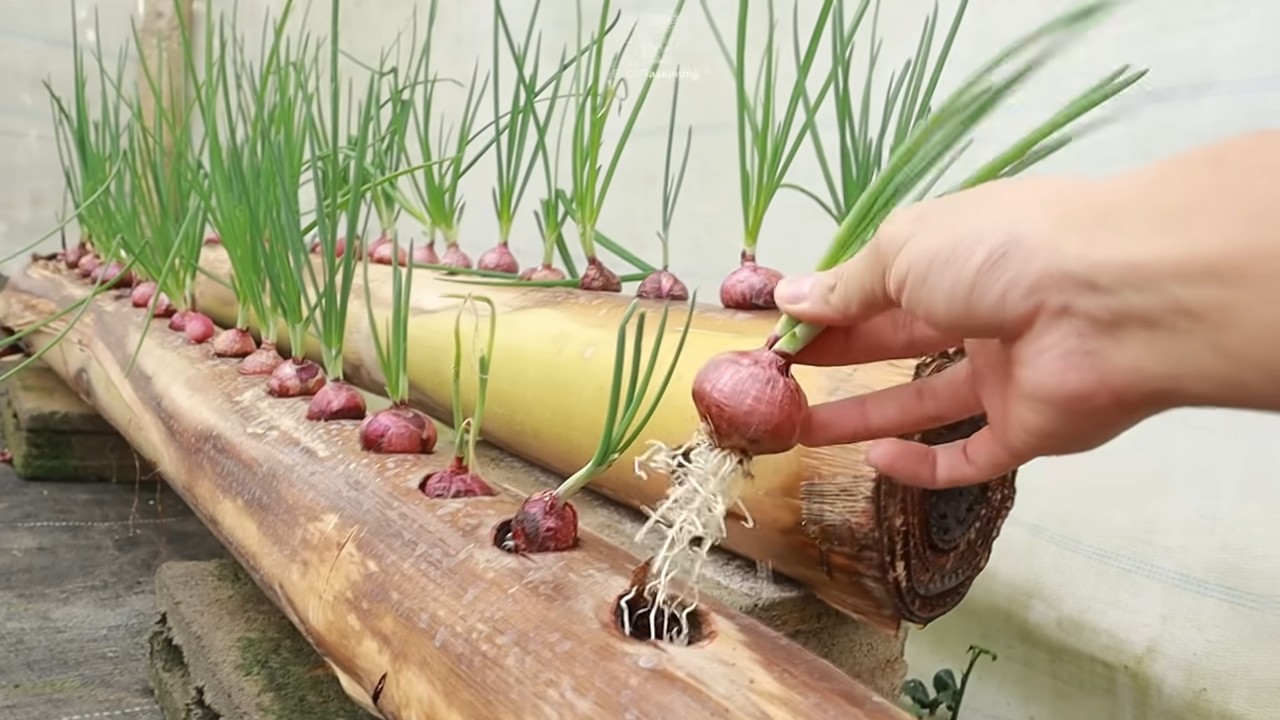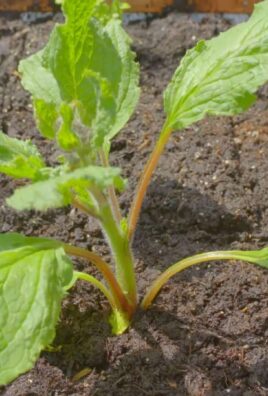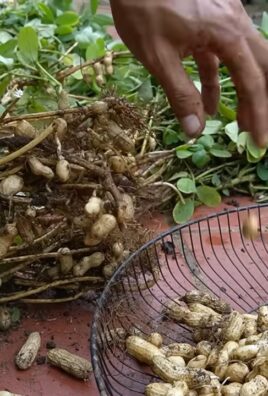Onion growing tricks – ever dreamt of pulling plump, juicy onions straight from your own backyard? I know I have! There’s something incredibly satisfying about nurturing your own food, and onions are a fantastic place to start. For centuries, onions have been a staple in cuisines around the world, dating back to ancient Egypt where they were even revered as symbols of eternity. From humble stews to gourmet dishes, they add depth and flavor that’s simply irreplaceable.
But let’s be honest, sometimes growing onions can feel a little…tricky. Maybe your bulbs are small, or perhaps they’re bolting before they even get a chance to mature. That’s where these DIY onion growing tricks come in! I’m going to share some simple yet effective hacks that will help you maximize your yield and enjoy a bountiful harvest.
Why do you need these tricks? Because everyone deserves to experience the joy of homegrown onions! Plus, store-bought onions can’t compare to the fresh, vibrant flavor of those you’ve nurtured yourself. So, get ready to ditch the store-bought varieties and unlock the secrets to successful onion growing tricks. Let’s get our hands dirty and grow some amazing onions together!

Growing Onions Like a Pro: My Foolproof DIY Guide
Hey there, fellow gardening enthusiasts! I’m so excited to share my tried-and-true methods for growing plump, juicy onions right in your backyard. Forget those bland, store-bought onions – with a little know-how, you can cultivate your own flavorful crop. This guide is packed with tips and tricks I’ve learned over the years, so get ready to become an onion-growing expert!
Choosing the Right Onions: Seeds, Sets, or Transplants?
Before we get our hands dirty, let’s talk about the different ways to start your onion journey. You have three main options: seeds, sets, and transplants. Each has its pros and cons, so let’s break them down:
* **Seeds:** Starting from seed gives you the widest variety to choose from and is generally the most economical option. However, it requires more time and effort, as you’ll need to start them indoors several weeks before the last frost.
* **Sets:** These are small, immature onion bulbs that are already partially grown. They’re easier to handle than seeds and will mature faster. Sets are a great option for beginners.
* **Transplants:** These are young onion plants that have already been started for you. They offer a good balance of convenience and variety, but they can be more expensive than seeds or sets.
I personally prefer using sets because they’re easy to plant and give me a head start on the growing season. But if you’re feeling adventurous and want to explore different varieties, go for seeds!
Preparing Your Onion Patch: Location, Soil, and Amendments
Onions are sun-loving plants, so choose a location that gets at least 6-8 hours of direct sunlight per day. The soil is also crucial. Onions need well-drained, fertile soil that’s rich in organic matter.
Here’s what I do to prepare my onion patch:
* **Soil Testing:** Before anything else, I recommend testing your soil’s pH level. Onions thrive in slightly acidic soil with a pH between 6.0 and 7.0. You can buy a soil testing kit at most garden centers.
* **Amending the Soil:** If your soil is heavy clay or sandy, you’ll need to amend it with organic matter. I like to use compost, well-rotted manure, or peat moss. These materials will improve drainage, aeration, and nutrient content.
* **Fertilizing:** Onions are heavy feeders, so it’s important to fertilize them regularly. Before planting, I incorporate a balanced fertilizer (like 10-10-10) into the soil. Follow the instructions on the fertilizer package for the correct application rate.
Planting Your Onions: A Step-by-Step Guide
Now for the fun part – planting! Whether you’re using seeds, sets, or transplants, the basic planting principles are the same.
Planting Onion Sets:
1. **Prepare the Soil:** Make sure your soil is loose and well-drained. Rake the surface smooth and remove any rocks or debris.
2. **Create Furrows:** Use a hoe or trowel to create shallow furrows in the soil, about 1 inch deep and 4-6 inches apart.
3. **Plant the Sets:** Place the onion sets in the furrows, spacing them about 2-3 inches apart. Make sure the pointed end of the set is facing up.
4. **Cover the Sets:** Gently cover the sets with soil, leaving the very tip of the bulb exposed.
5. **Water Thoroughly:** Water the newly planted sets thoroughly to help them settle in.
Planting Onion Transplants:
1. **Harden Off Transplants:** If you purchased your transplants from a nursery, it’s important to harden them off before planting. This means gradually exposing them to outdoor conditions over a period of a week or so.
2. **Prepare the Soil:** Just like with sets, make sure your soil is loose and well-drained.
3. **Dig Holes:** Dig small holes in the soil, spacing them about 4-6 inches apart. The holes should be deep enough to accommodate the root ball of the transplant.
4. **Plant the Transplants:** Gently remove the transplants from their containers and place them in the holes.
5. **Backfill and Water:** Backfill the holes with soil, gently firming it around the base of the plants. Water thoroughly.
Planting Onion Seeds:
1. **Start Indoors:** Start onion seeds indoors 8-10 weeks before the last expected frost. Use seed starting trays and a good quality seed starting mix.
2. **Sow Seeds:** Sow seeds about ¼ inch deep and keep the soil moist.
3. **Provide Light:** Once the seedlings emerge, provide them with plenty of light. A grow light is ideal, but a sunny windowsill can also work.
4. **Harden Off Seedlings:** Before transplanting outdoors, harden off the seedlings as described above.
5. **Transplant Outdoors:** Transplant the seedlings outdoors after the last frost, spacing them about 4-6 inches apart.
Caring for Your Onions: Watering, Weeding, and Fertilizing
Once your onions are planted, it’s important to provide them with the care they need to thrive. Here’s what I do to keep my onions happy and healthy:
* **Watering:** Onions need consistent moisture, especially during bulb formation. Water deeply whenever the top inch of soil feels dry. Avoid overwatering, as this can lead to rot.
* **Weeding:** Weeds compete with onions for nutrients and water, so it’s important to keep your onion patch weed-free. Hand-pull weeds regularly or use a hoe to cultivate the soil. Be careful not to damage the onion bulbs.
* **Fertilizing:** As I mentioned earlier, onions are heavy feeders. I like to side-dress my onions with a nitrogen-rich fertilizer every 2-3 weeks during the growing season. Fish emulsion or blood meal are great organic options.
* **Mulching:** Applying a layer of mulch around your onions can help to conserve moisture, suppress weeds, and regulate soil temperature. Straw, shredded leaves, or wood chips are all good choices.
Dealing with Pests and Diseases: Prevention and Treatment
Onions are generally pest-resistant, but they can be susceptible to certain problems. Here are a few common pests and diseases to watch out for:
* **Onion Maggots:** These are small, white larvae that feed on the roots of onions. They can cause plants to wilt and die. To prevent onion maggots, use row covers to protect your plants. You can also apply beneficial nematodes to the soil.
* **Thrips:** These tiny insects suck the sap from onion leaves, causing them to turn silvery and distorted. To control thrips, spray your plants with insecticidal soap or neem oil.
* **Downy Mildew:** This fungal disease causes yellow spots on onion leaves. To prevent downy mildew, provide good air circulation and avoid overhead watering. If you see signs of downy mildew, spray your plants with a fungicide.
Harvesting Your Onions: When and How
The moment you’ve been waiting for – harvesting! Onions are typically ready to harvest when the tops begin to fall over.
Here’s how I harvest my onions:
1. **Loosen the Soil:** Use a garden fork to gently loosen the soil around the onion bulbs.
2. **Pull the Onions:** Carefully pull the onions from the soil, being careful not to damage them.
3. **Cure the Onions:** Cure the onions by laying them out in a single layer in a warm, dry, well-ventilated place for 2-3 weeks. This will allow the outer layers to dry and toughen, which will help to prevent rot.
4. **Store the Onions:** Once the onions are cured, you can store them in a cool, dry place for several months. I like to braid the tops together and hang them in my basement.
Tips and Tricks for Onion-Growing Success
Here are a few extra tips and tricks I’ve learned over the years:
* **Choose the Right Variety:** Different onion varieties are suited to different climates and growing conditions. Do some research to find varieties that will thrive in your area.
* **Rotate Your Crops:** Avoid planting onions in the same location year after year. Crop rotation can help to prevent soilborne diseases and pests.
* **Don’t Overcrowd:** Give your onions plenty of space to grow. Overcrowding can lead to stunted growth and disease problems.
* **Water Deeply:** When you water your onions, water deeply to encourage strong root growth.
* **Be Patient:** Onions take time to mature, so don’t get discouraged if they don’t grow overnight. With a little patience and care, you’ll be rewarded with a bountiful harvest.
I hope this guide has inspired you to grow your own onions. It’s a rewarding experience, and you’ll be amazed at the difference in flavor between homegrown onions and store-bought ones. Happy

Conclusion
So, there you have it! These simple yet effective onion growing tricks are your secret weapon to achieving a bountiful harvest of plump, flavorful onions right in your own backyard. Forget relying solely on store-bought produce; imagine the satisfaction of pulling up your own organically grown onions, knowing exactly where they came from and how they were nurtured.
This isn’t just about saving money (although that’s a definite perk!). It’s about connecting with nature, understanding the growing process, and enjoying the unparalleled taste of homegrown goodness. The difference between a store-bought onion and one you’ve lovingly cultivated is truly remarkable. The flavor is more intense, the texture is crisper, and the overall experience is simply more rewarding.
But the best part? These tricks are incredibly accessible. You don’t need a sprawling farm or years of experience to succeed. Whether you’re a seasoned gardener or a complete beginner, these techniques are designed to be easy to implement and yield impressive results.
Consider these variations to personalize your onion growing journey:
* Experiment with different onion varieties: From sweet Vidalia onions to pungent red onions, there’s a whole world of flavors to explore. Try growing a mix of varieties to cater to your culinary preferences.
* Companion planting: Onions thrive when planted alongside certain companion plants. Carrots, for example, deter onion flies, while onions repel carrot root flies. Research companion planting strategies to maximize your garden’s potential.
* Vertical gardening: If you’re short on space, consider growing onions in vertical planters or hanging baskets. This is a great way to maximize your yield in a small area.
* Hydroponics: For the adventurous gardener, hydroponic onion growing offers a controlled environment and potentially faster growth rates.
Don’t be afraid to get your hands dirty and experiment. Gardening is a journey of learning and discovery, and there’s no one-size-fits-all approach. The key is to be patient, observant, and willing to adapt your techniques as needed.
We wholeheartedly encourage you to try these onion growing tricks and witness the magic for yourself. Start small, perhaps with just a few onion sets or seedlings, and gradually expand your garden as you gain confidence.
And most importantly, we want to hear about your experiences! Share your successes, your challenges, and any tips or tricks you’ve discovered along the way. Post photos of your thriving onion patch on social media using #HomegrownOnions and tag us so we can celebrate your achievements. Let’s create a community of passionate gardeners who are dedicated to growing their own delicious, healthy food.
Growing your own onions is more than just a gardening project; it’s an investment in your health, your well-being, and your connection to the natural world. So, grab your gardening gloves, get ready to dig in, and prepare to be amazed by the bounty that awaits you. Happy gardening!
Frequently Asked Questions (FAQ)
What are the most common mistakes people make when growing onions, and how can I avoid them?
One of the biggest mistakes is planting onions too close together. Onions need ample space to develop properly, so ensure you’re following the recommended spacing guidelines for your chosen variety. Overwatering is another common pitfall, leading to root rot and other problems. Water deeply but infrequently, allowing the soil to dry out slightly between waterings. Finally, neglecting to fertilize your onions can result in stunted growth and poor bulb development. Use a balanced fertilizer specifically formulated for vegetables, following the instructions on the label.
How do I know when my onions are ready to harvest?
The most reliable indicator is when the onion tops begin to fall over and turn yellow or brown. This signals that the plant has reached maturity and is redirecting its energy into bulb development. You can also gently feel the bulb; it should be firm and well-formed. Don’t wait too long after the tops fall over, as the bulbs can start to rot if left in the ground for an extended period.
What’s the best way to store homegrown onions to maximize their shelf life?
Proper curing is essential for long-term storage. After harvesting, gently brush off any excess soil and lay the onions out in a single layer in a well-ventilated, dry place for about two to three weeks. This allows the outer layers to dry and harden, preventing rot. Once cured, store the onions in a cool, dark, and dry location, such as a basement or pantry. Avoid storing them in plastic bags, as this can trap moisture and promote spoilage. Mesh bags or loosely woven baskets are ideal.
Can I grow onions from scraps?
Yes, you can! While it’s not as reliable as starting from sets or seedlings, growing onions from scraps is a fun and sustainable way to propagate new plants. Simply take the root end of an onion (about an inch or two) and plant it in soil, leaving the top exposed. Keep the soil moist, and new shoots should emerge within a few weeks. However, be aware that onions grown from scraps may not produce as large or as uniform bulbs as those grown from traditional methods.
What are some natural ways to control pests and diseases in my onion patch?
Companion planting is a great way to deter pests naturally. Planting carrots alongside onions can help repel onion flies and carrot root flies. You can also use organic pest control methods, such as neem oil or insecticidal soap, to control aphids, thrips, and other common onion pests. To prevent fungal diseases, ensure good air circulation around your plants and avoid overhead watering. If you notice any signs of disease, remove the affected plants immediately to prevent the spread.
What type of soil is best for growing onions?
Onions prefer well-drained, fertile soil that is rich in organic matter. A slightly acidic to neutral pH (around 6.0 to 7.0) is ideal. Before planting, amend your soil with compost or well-rotted manure to improve its fertility and drainage. If your soil is heavy clay, consider adding sand or perlite to improve drainage.
How often should I water my onions?
Onions need consistent moisture, especially during bulb development. Water deeply whenever the top inch of soil feels dry to the touch. Avoid overwatering, as this can lead to root rot. During periods of heavy rain, you may need to reduce watering frequency.
Can I grow onions in containers?
Yes, onions can be successfully grown in containers, making them a great option for gardeners with limited space. Choose a container that is at least 8 inches deep and wide, and use a well-draining potting mix. Be sure to water and fertilize your container-grown onions regularly, as they will dry out and deplete nutrients more quickly than those grown in the ground.
What are the benefits of using onion growing tricks?
The benefits are numerous! These tricks can lead to larger, healthier onion bulbs, increased yields, and improved flavor. They can also help you save money on groceries, reduce your reliance on store-bought produce, and connect with nature in a meaningful way. Ultimately, these onion growing tricks empower you to grow your own delicious, nutritious food right in your own backyard.





Leave a Comment